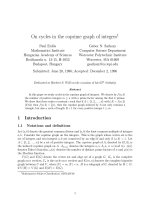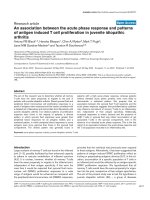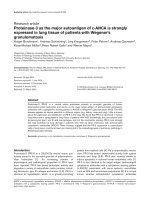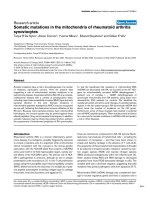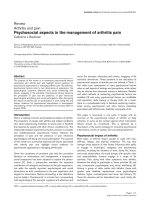Báo cáo y học: "Physical anhedonia in the acute phase of schizophrenia" doc
Bạn đang xem bản rút gọn của tài liệu. Xem và tải ngay bản đầy đủ của tài liệu tại đây (216.95 KB, 5 trang )
BioMed Central
Page 1 of 5
(page number not for citation purposes)
Annals of General Psychiatry
Open Access
Primary research
Physical anhedonia in the acute phase of schizophrenia
Vassilis P Kontaxakis*
1
, Costas T Kollias
1
, Beata J Havaki-Kontaxaki
1
,
Maria M Margariti
1
, Sophia S Stamouli
1
, Eleni Petridou
2
and
George N Christodoulou
3
Address:
1
Department of Psychiatry, University of Athens, Eginition Hospital, 74 Vas. Sophias Ave, 11528 Athens, Greece,
2
Department of Hygiene
and Epidemiology, University of Athens, 75 Micras Asias Ave, 11527, Goudi, Athens, Greece and
3
Hellenic Centre for Mental Health and Research,
58 Notara Ave, 10683 Athens, Greece
Email: Vassilis P Kontaxakis* - ; Costas T Kollias - ; Beata J Havaki-Kontaxaki - ;
Maria M Margariti - ; Sophia S Stamouli - ; Eleni Petridou - ;
George N Christodoulou -
* Corresponding author
Abstract
Background: The aim of the current study is to investigate the relationship between physical
anhedonia and psychopathological parameters, pharmacological parameters or motor side-effects
in a sample of inpatients with schizophrenia in an acute episode of their illness.
Method: Eighty one patients with schizophrenia, consecutively admitted, with an acute episode of
their illness, at the Eginition Hospital, Department of Psychiatry, University of Athens, during a one-
year period were investigated regarding possible relationships between physical anhedonia, social-
demographic data and clinical parameters as well as motor side-effects, induced by antipsychotic
agents. All patients were assessed using the Chapman Revised Physical Anhedonia Scale (RPAS), the
Positive and Negative Syndrome Scale (PANSS), the Rating Scale for Extrapyramidal Side-Effects
(EPSE), the Barnes Akathisia Rating Scale (BARS) and the Abnormal Involuntary Movement Scale
(AIMS). Simple cross tabulations were initially employed. Subsequently, multiple regression analysis
was performed.
Results: Both positive and negative symptoms were associated with physical anhedonia. A positive
association between physical anhedonia and the non-paranoid sub-category of schizophrenia was
also proved.
Conclusion: According to these results, it seems that in the acute phase of schizophrenia, physical
anhedonia may be a contributing factor to patient's psychopathology.
Background
Anhedonia, a term first used by Ribot [1], describes the
lack of interest and the withdrawal from all the usual and
pleasant activities. Anhedonia has been described as a
schizophrenic symptom by many authors, including
Bleuler and Kraepelin [2,3]. Rado [4,5] had suggested that
anhedonia is a central, genetically transmitted defect both
in overt schizophrenia and in compensated schizotypes.
Meehl [6] has integrated Rado's views into a theory of
neurological dysfunction in schizophrenia and proposed
Published: 18 January 2006
Annals of General Psychiatry 2006, 5:1 doi:10.1186/1744-859X-5-1
Received: 12 October 2005
Accepted: 18 January 2006
This article is available from: />© 2006 Kontaxakis et al; licensee BioMed Central Ltd.
This is an Open Access article distributed under the terms of the Creative Commons Attribution License ( />),
which permits unrestricted use, distribution, and reproduction in any medium, provided the original work is properly cited.
Annals of General Psychiatry 2006, 5:1 />Page 2 of 5
(page number not for citation purposes)
that anhedonia is an enduring trait, a "cardinal symptom"
preceding and possibly causing schizophrenia.
According to Chapman et al [7], there are two types of
anhedonia, physical anhedonia and social anhedonia.
Physical anhedonia which, usually, precedes the onset of
the disease, represents a defect in the ability to experience
physical pleasures, such as pleasures of eating, touching e.
t. c., while social anhedonia represents a defect in the abil-
ity to experience interpersonal pleasure, such as pleasure
of being with people, talking e. t. c.
There have been contradictory results regarding the asso-
ciation of anhedonia or its components to clinical param-
eters (i.e. negative symptoms, positive symptoms,
depression) or to drug – treatment. Furthermore, there is
a lack of studies regarding the relationship between phys-
ical anhedonia and psychopathological parameters in the
acute phase of schizophrenia or between physical anhe-
donia and motor side – effects induced by antipsychotic
agents.
The aim of the current study was to investigate the rela-
tionship between physical anhedonia and social-demo-
graphic, clinical parameters as well as motor side-effects in
a sample of inpatients with schizophrenia in the acute
phase of their illness.
Methods
Subjects
All patients with schizophrenia, consecutively admitted,
with an acute episode of their illness, at the Eginition Hos-
pital, Department of Psychiatry, University of Athens, dur-
ing a one-year period were studied. Written informed
consent was obtained from the subjects and their rela-
tives.
The patients' diagnoses were made by two independent
psychiatrists of similar level of education and experience
according to DSM-IV criteria [8] and were reviewed on the
day of discharge, taking into account all information col-
lected during the inpatient period. Patients who presented
with any other diagnosis on Axis I of DSM-IV, serious
physical illness (especially neurological), substance abuse
and mental retardation were excluded from the study.
Eighty one patients were finally diagnosed as suffering
from schizophrenia. Fifty were male (62%) and 31 female
(38%). Their mean age was 30.95 (± 8.91) years, (age
range 17 to 50 years). They had a mean of 12.6 (± 2.7)
years of education, a mean duration of illness of 6.9 (±
7.6) years and a mean duration of hospitalisations of 0.4
(± 0.8) years. Most of the patients were single (85%).
Patients were divided into the following subcategories:
Paranoid type (57%), undifferentiated type (20%), disor-
ganised type (13%), residual type (10%). 27 patients
(34%) were for the first time admitted while 54 (66%)
had more than one admissions (relapsers).
At the time of assessment, 65 patients (77%) were receiv-
ing antipsychotic drugs. Out of a total of 81 patients on
antipsychotic drugs, 62% were receiving conventional
antipsychotics, 27% used atypical antipsychotics as mon-
otherapy and 12% used conventional plus atypical antip-
sychotics in combination. Eleven patients (13.6%) were
consuming antidepressants, 41 (50.6%) anxiolytics, 2
(2.5%) mood stabilizers and 45 (55.6%) anti-parkinso-
nian agents.
Clinical assessments
All patients were assessed using the following scales: the
Chapman Revised Physical Anhedonia Scale [RPAS] (9),
the Positive and Negative Syndrome Scale (PANSS)
[10,11], the Rating Scale for Extrapyramidal Side-Effects
(EPSE) [12], the Barnes Akathisia Rating Scale (BARS)
[13] and the Abnormal Involuntary Movement Scale
(AIMS) [14,15]. The severity of depression was estimated
using the depression cluster score of the PANSS (items
G1+G2+G3+G6) [16,17].
Means and standard deviations of the main variables are
shown in table 1.
Subjects were assessed during the first week of their hospi-
talisation by three independent psychiatrists-raters. The
first rater assessed the patients using the RPAS and the
AIMS, the second using the PANSS and the EPSE and the
third using the BARS. Information from the patient's his-
tory, concerning social-demographic and clinical parame-
ters was recorded in a pre-coded interview form. The
antipsychotic agents dosage was estimated in chlorpro-
mazine equivalents [18,19].
Table 1: Mean patients' scores
Scale Mean (SD)
PAS 19.10 (± 7.38)
PANSS – Positive symptoms 18.47 (± 6.61)
PANSS – Negative symptoms 20.20 (± 8.09)
PANSS – General psychopathology symptoms 39.27 (± 11.30)
PANSS – Depression 9.91 (± 2.94)
EPSE 0.76 (± 0.58)
BARS 0.30 (± 0.53)
AIMS 0.12 (± 0.30)
PAS: Physical Anhedonia Scale, PANSS: Positive and Negative
Syndrome Scale, EPSE: Rating Scale for Extrapyramidal Side-Effects,
BARS: the Barnes Akathisia Rating Scale, AIMS: Abnormal Involuntary
Movement Scale
Annals of General Psychiatry 2006, 5:1 />Page 3 of 5
(page number not for citation purposes)
Statistical analyses
The SPSS 8.0 was used for the statistical analysis. Since
there is no cut-off point for schizophrenia, dividing anhe-
donic subjects from non-anhedonic ones, physical anhe-
donia scores were divided in thirtiles according to the
ratings in rPAS (1
st
thirtile: <15 and <14, 2
nd
thirtile: 16–
22 and 15–21, 3
rd
thirtile: >23 and >22 for men and
women respectively). Then, possible correlations were
explored between: physical anhedonia and social-demo-
graphic parameters (i.e. sex, age, family status e.t.c.), clin-
ical parameters (i.e. diagnostic sub-category) and
psychopathological parameters derived from the afore-
mentioned scales and their subscales used. Simple cross
tabulations were initially employed. Of all the parameters
cross-tabulated with physical anhedonia, statistically sig-
nificant differences between subjects with lower anhedo-
nia scores and subjects with higher anhedonia scores were
found only for the PANSS positive sub-scale score, the
PANSS negative sub-scale score and the dianostic sub-cat-
egory parameter. Subsequently, multiple regression anal-
ysis was performed, using as predictor core model the
following variables: gender, age, family status, diagnosis
and years of education and diagnostic sub-category. Alter-
native introduced clinical standard variables to the core
model were the PANSS positive sub-scale score and the
PANSS negative sub-scale score. The physical anhedonia
score was the dependent variable.
Results
Tables 2 shows the distribution of the sample crossclassi-
fied by sociodemographic, clinical variables and the phys-
ical anhedonia score thirtiles. The severity of physical
anhedonia was significantly related to the diagnostic sub-
category of non-paranoid schizophrenia, to the positive
symptoms score and to the negative symptoms score of
the PANSS.
Table 3 shows the associations of physical anhedonia
scores with the core model variables and the multiple
regression analysis results. There were statistically signifi-
cant associations of physical anhedonia scores with alter-
native clinical variables which were introduced to the core
model. Single patients tended to have higher scores of
physical anhedonia than others (p = 0.05). Older patients
tended to score higher on physical anhedonia (p = 0.05).
Patients with paranoid schizophrenia had lower scores of
physical anhedonia than non-paranoid patients with
schizophrenia (p = 0.004). Both positive symptoms score
and negative symptoms score were positive predictors of
physical anhedonia (P = 0.03 and P = 0.01, respectively).
Discussion
This is the first study searching simultaneously for possi-
ble association between physical anhedonia and positive
symptoms, negative symptoms or general psychopathol-
Table 2: Distribution of 81 patients with schizophrenia by sociodemographic and clinical variables and the percentages of the physical
anhedonia score calculated for each gender
Variable physical anhedonia score thirtiles p=
1
st
(%) 2
nd
(%) 3
rd
(%)
Gender
Male 17 34.0 15 30.0 18 36.0 0.64
Female 10 32.3 11 35.6 10 32.3
Age (years)
< 25 years 10 43.5 10 43.5 3 13.0 0.09
25–34 9 29.0 8 25.8 14 45.2
>35 8 29.6 8 29.6 11 40.8
Education (years)
≤ 12 13 28.9 15 33.3 17 37.8 0.35
>13 1438.81130.61130.6
Family status
Unmarried 19 27.5 26 37.7 24 34.8 0.12
Other 8 66.7 0 0.0 4 33.3
Diagnostic sub-category
Paranoid 22 47.8 13 28.3 11 23.9 0.002*
Other 5 14.3 13 37.1 17 48.6
PANSS-positive subscale score
≤ 19 20 42.6 15 31.9 12 25.5 0.02*
>20 7 20.6 11 32.3 16 47.1
PANSS-negative subscale score
≤ 19 17 40.5 15 35.7 10 23.8 0.04*
>20 1025.61128.21846.2
*statistically significant difference, Chi – square tests
Annals of General Psychiatry 2006, 5:1 />Page 4 of 5
(page number not for citation purposes)
ogy symptoms as well as motor side effects induced by
antipsychotic agents in inpatients with schizophrenia in
the acute phase of their illness.
Starting with, we should mention several limitations of
our study. First, we used a mixed population of patients
with schizophrenia regarding their medication status. Sec-
ond, there was a lack of a specific scale measuring depres-
sion in schizophrenia. Third, we studied patients in the
acute phase of their illness. Hence, it was possible that
positive symptoms may dominate and overlap the clinical
manifestation of the disease.
According to our results, the severity of physical anhedo-
nia was associated with the severity of both positive and
negative symptoms. Also, a positive association between
physical anhedonia and the sub-category of non-paranoid
schizophrenia was presented. However, the severity of
physical anhedonia was found to be independent to
depression, to general psychopathology symptoms or
motor side-effects induced by antipsychotic agents.
Regarding the relationship of physical anhedonia and
negative symptoms the results are in line with those by
Loas et al [20] and Kirkpatrick et al [21] who have demon-
strated that physical anhedonia and deficit symptoms,
which are described as enduring negative symptoms, were
significantly related. Yet, Herbener et al [22] found that
the PAS score of patients with schizophrenia was signifi-
cantly correlated to negative symptoms, estimated by the
SADS structured interview, at the 4.5 year follow up
assessment. However, contrary to our results, Loas et al
[23] found that physical anhedonia in chronic patients
with schizophrenia was not significantly related to nega-
tive symptoms, estimated by both the PANSS and the
BPRS. Other studies, as well, have reported an absence of
significant correlation between physical anhedonia and
negative symptoms as measured by the Positive and Neg-
ative Symptoms Scale (PANSS), the Brief Psychiatric Rat-
ing Scale (BPRS), or the SANS [24-26].
Regarding the relationship of physical anhedonia and
positive symptoms, contrary to our results, Herbener et al
[22] found that the PAS score of patients with schizophre-
nia was not correlated to florid psychotic symptoms, esti-
mated by the SADS, over a 10 – year follow up period.
Also, Loas et al [23] found that physical anhedonia in
chronic patients with schizophrenia was not significantly
related to positive symptoms, estimated by both the
PANSS and the BPRS.
Regarding the relationship of physical anhedonia and the
non-paranoid sub-type of schizophrenia, contrary to our
results, Schunck et al [27] did not find a correlation
between the PAS score and the schizophrenia sub-type in
a sample of out-patients with schizophrenia.
The observation that physical anhedonia is independent
of depression in schizophrenia seems to be consistent
with the findings of Herbener et al [22]. They used a sub-
scale of the SADS to estimate depression. Also, Loas et al
[23] have found that physical anhedonia in chronic
patients with schizophrenia was not significantly related
to depression, estimated by the Beck Depression Inven-
tory.
Regarding the relationship of physical anhedonia and
general psychopatology symptoms, similar to our results
are the findings of Loas et al [23] who have found that
physical anhedonia in chronic patients with schizophre-
nia was not significantly related to general psychopathol-
ogy symptoms, estimated by both the PANSS and the
BPRS.
We did not find any studies exploring the the relationship
between physical anhedonia and motor side effects
induced by antipsychotic agents.
Table 3: Multiple regression-derived partial regression
coefficients (b), standard errors (SE) and corresponding p-values
for prediction of physical anhedonia from core model variables
and clinical standard variables
Variable Category B SE p=
Core model
Gender
Male
Female -0.41 1.63 0.81
Age (years)
<25
25–34
>35 1.99 1.01 0.05
Education (years)
≤ 12 years
>13 -2.13 1.55 0.17
Family Status
Unmarried
Other -4.69 2.31 0.05
Diagnostic sub-category
Paranoid
Other 4.63 1.57 0.004 *
Alternative introduced variables to the core model
Model 1
PANSS-positive subscale score ≤ 19
>20 3.34 1.54 0.03 *
Model 2
PANSS-negative subscale score ≤ 19
>20 3.89 1.53 0.01 *
* statistically significant difference
Publish with BioMed Central and every
scientist can read your work free of charge
"BioMed Central will be the most significant development for
disseminating the results of biomedical research in our lifetime."
Sir Paul Nurse, Cancer Research UK
Your research papers will be:
available free of charge to the entire biomedical community
peer reviewed and published immediately upon acceptance
cited in PubMed and archived on PubMed Central
yours — you keep the copyright
Submit your manuscript here:
/>BioMedcentral
Annals of General Psychiatry 2006, 5:1 />Page 5 of 5
(page number not for citation purposes)
Conclusion
According to our results, it seems that in the acute phase
of schizophrenia, physical anhedonia may be a compo-
nent of patient's psychopathology. Further studies to elu-
cidate the nature of physical anhedonia and its
relationship to various phases of the schizophrenic disor-
der are needed.
References
1. Ribot TH: The psychology of emotions London: Scott; 1897.
2. Bleuler E: Originally Published, 1911. In Dementia praecox or the
group of schizophrenias Edited by: Tranl, Zinkin J. New York: Interna-
tional Universities Press; 1950.
3. Kraepelin E: Originally Published, 1913. In Dementia praecox and
paraphrenia Edited by: Transl, Baclay BM. Edinburg E & S Livingstone;
1919.
4. Rado S: Psychoanalysis of Behaviour; Collected Papers New York: Grune
and Stratton; 1956.
5. Rado S: Psychoanalysis of Behaviour; Collected Papers. 1956–1961 Vol-
ume 2. New York: Grune and Stratton; 1962.
6. Meehl PE: Schizotaxia, schizotypy, schizophrenia. American Psy-
chologist 1962, 17:827-838.
7. Chapman LJ, Chapman JP, Raulin ML: Scales for physical and social
anhedonia. J Abn Psychology 1976, 85:374-382.
8. American Psychiatric Association: Diagnostic and Statistical Manual of
Mental Disorders Fourth edition. Washington DC; 1994.
9. Chapman LJ, Chapman JP: Revised Physical Anhedonia Scale.
Unpublished test 1978.
10. Kay SR, Fiszbein A, Opler LA: The positive and negative syn-
drome scale (PANSS) for schizophrenia. Schizophr Bull 1987,
13:261-276.
11. Lykouras L, Botsis A, Oulis P: Positive and Negative Syndrome Scale.
Translation – Validity – Reliability (in Greek) Athens: Tsiveriotis eds;
1997.
12. Simpson CM, Angus J: A rating scale for extrapyramidal effects.
Acta Psychiatr Scand 1970, 212(Suppl 1):11-19.
13. Barnes TRE: A rating scale for drug-induced akathisia. Br J Psy-
chiatry 1989, 154:672-676.
14. Munetz MR, Benjamin S: How to examine patients using the
Abnormal Involuntary Movement Scale. Hosp Comm Psychiatry
1998, 39(11):1172-1177.
15. Guy W: ECDEU Assessment Manual for Psychopharmacology, revised ed
Washington DC: US Department of Health, Education and Welfare;
1976.
16. Kay SR, Sevy S: Pyramidal model of schizophrenia. Schizophr Bull
1990, 16:537-545.
17. Kay SR: Positive and Negative syndromes in schizophrenia: Assessment and
research New York: Brunner/Mazel; 1991.
18. Kalyna Z: Clinical Handbook of Psychotropic drugs Fifth Revised edition.
Seattle: Hogrefe & Huber Publishers; 1995.
19. Casey PE: Side-effect profiles of new antipsychotic agents. J
Clin Psychiatry 1996, 57(Suppl 11):40-45.
20. Loas G, Noisette C, Legrand A, Boyer P: Anhedonia, depression
and the deficit syndrome of schizophrenia. Acta Psychitr Scand
1996, 94:477-479.
21. Kirkpatrick B, Buchanan RW: Anhedonia and the deficit syn-
drome in schizophrenia. Psychiatry Res 1990, 31:25-30.
22. Herbener E, Harrow M: The course of anhedonia during 10
years of schizophrenic illness. J Abn Psychology 2002,
111(2):237-248.
23. Loas G, Boyer P, Legrand A: Anhedonia and negative symp-
tomatology in chronic schizophrenia. Compr Psychiatry 1996,
37(1):5-11.
24. Loas G, Noisette C, Legrand A, Boyer P: Is anhedonia a specific
dimension in chronic schizophrenia? Schizoph Bull 2000,
26(2):495-506.
25. Berenbaum H, Oltmanns TF: Emotional experience and expres-
sion in schizophrenia and depression. J Abn Psychology 1992,
101:37-44.
26. Blanchard JJ, Bellack AS, Mueser KT: Affective and social-behav-
ioral correlates of physical and social anhedonia in schizo-
phrenia. J Abn Psychology 1994, 103:719-728.
27. Schuck J, Leventhal D, Rothstein H, Irizary V: Physical anhedonia
and schizophrenia. J Abn Psychology 1984, 93(3):342-344.

